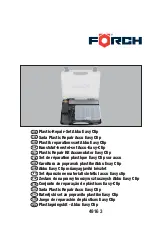
Section 2: Operating Procedures
CB0550 4-in-1 Combination Bucket 381-139M
2/5/19
13
Section 2: Operating Procedures
Startup Checklist
Hazard control and accident prevention are dependent
upon the awareness, concern, prudence, and proper
training involved in the operation, transport, storage, and
maintenance of the 4-in-1 Combination Bucket.
Therefore, it is absolutely essential that no one operates
the bucket unless they are age 16 or older and have read,
fully understood, and are totally familiar with the
Operator’s Manual. Make sure the operator has paid
particular attention to:
•
Important Safety Information
, page 1
•
•
Section 2: Operating Procedures
•
Perform the following inspections before using your
CB0550 4-in-1 Combination Bucket.
General Inspection
Make the following inspections with bucket attached to a
tractor parked on a level surface.
1.
Complete Operating Checklist provided above.
2. Inspect tractor safety equipment to make sure it is in
good working condition and that all safety alert
decals are visible and legible. Replace all missing
and/or illegible safety alert decals. See
3. Inspect hitch hook-up to bucket:
•
Standard Hook-up:
Make sure cylinder rod is
secured to center clevis with hitch pin, hitch pin
bolt, and locknut. Make sure loader arms are
secured to clevises with hitch pins and hairpins.
•
Quick Hitch Hook-up:
Make sure center j-hook is
secured under the bucket’s center hitch pin and
hitch pin is secured with hex bolt and locknut.
Make sure loader arms are secured to the clevis
plates with hitch pins and linchpins.
Operating Checklist
Check
Page
Make sure all guards & shields are in place &
in good working condition.
None
Follow hook-up instructions.
Refer to “Section 1: Assembly & Set-up”.
Check hitch hook-up.
Refer to “Hook-up With BX Quick Hitch” or
“Hook-up Without BX Quick Hitch”.
Make sure operator has read and
understands how to operate the 4-in-1
Combination Bucket.
Refer to “Section 2: Operating Procedures”.
Required maintenance has been completed.
Refer to “Section 3: Maintenance”.
Check bucket initially and periodically for
loose bolts and pins. Refer to “Torque Values
Chart”.
4. Consult your tractor Operator’s Manual to determine
if ballast is required. Add ballast if necessary.
5. Inspect condition of hydraulic hoses, fittings, and
valves before starting the tractor. Make sure hoses
do not contact moving parts, and they are not
pinched, kinked, twisted, or frayed.
6. Operate hydraulic controls to verify control
movements function properly and equipment
movements are correct. Make any necessary
changes to controls and hydraulic hook-ups before
putting equipment into service.
7.
Operate bucket through its full range of movements
to check for clearances. Refer to
on page 12 for detailed instructions.
8. Purge hydraulic system of trapped air by operating all
hydraulic functions several times before putting unit
into service.
Operating Safety
DANGER
!
To avoid serious injury or death:
•
The operator of this attachment must know how to control
the power machine with attachment and how to stop them
•
Keep attachment, loader arms, and/or load away from
overhead electrical power lines. Place an orange warning
sign under overhead lines indicating type of danger above.
•
Do not drive up to anyone or an animal in front of a fixed
object such as a wall or bench. Never assume that the power
•
Keep bystanders, pets, and livestock away from your work
area. Never allow anyone to go near or under the
attachment or its load. The attachment and/or load can fall.
•
Make sure all objects are contained and/or secured before
lifting. Do not lift a load that cannot be contained in the
attachment as the load can shift and fall.
•
Do not lift a load that cannot be contained in the
•
Keep load positioned forward enough to prevent accidental
spillage on operator and power machine.
•
Keep load slightly tilted back to secure its weight against
the hitch frame. Rotating top of hitch frame back too far can
cause load to shift and fall rearward onto the machine and/
or operator. Rotating top of hitch frame forward too far can
cause load to shift and fall forward.
•
Use a “spotter” when it is hard to see in the direction you
are traveling and when placing a load that obstructs your
vision. A person or animal could be nearby in a blind spot.
•
Be safe, lift only loads with the loader arms that can be kept
under control and contained. An uncontrolled load can
result in a serious injury or death.
•
Make sure the machine is stopped on solid, level ground












































